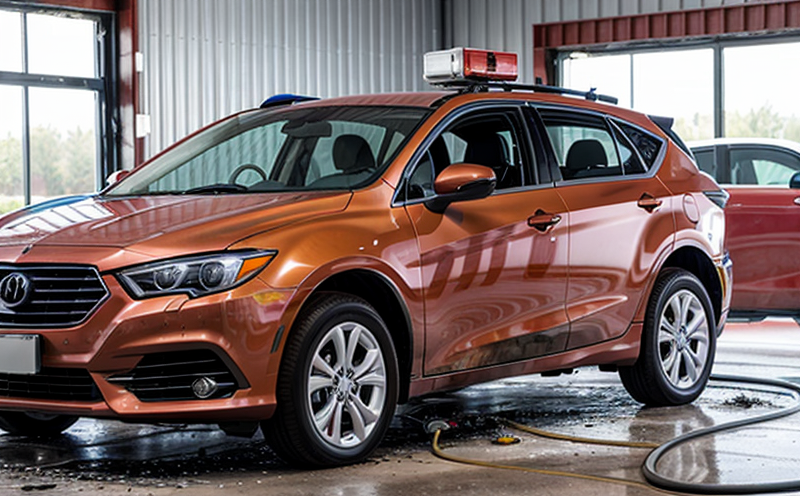Fire Resistance Testing of Automotive Seat Cushions
The fire resistance testing of automotive seat cushions is a critical process that ensures vehicles meet stringent safety standards and regulations. This test evaluates the ability of the seat cushion to withstand exposure to an ignition source without catching fire or releasing toxic fumes, thereby protecting passengers in case of a vehicle fire.
In the automotive industry, seat cushions are exposed to various stressors during manufacturing and use, including high temperatures from engine compartments, frictional heat, and accidental ignitions. Fire resistance testing ensures that these cushions can maintain their structural integrity under such conditions, reducing the risk of further hazards in case of an accident or fire.
The test typically involves placing a specimen of the seat cushion onto a metal frame with a specified load. The specimen is then subjected to a controlled flame for a set duration. During this time, the tester monitors the behavior of the cushion, including its propensity to melt, char, or catch fire. After the exposure period, the sample undergoes further inspection to determine if it has passed the test based on specific acceptance criteria.
The importance of this testing cannot be overstated. A failed seat cushion could lead to catastrophic failure during a fire, potentially trapping passengers inside and exacerbating injuries. This is why compliance with relevant standards such as ISO 16925:2003 and ASTM F1387-14 is essential.
Understanding the test parameters and instrumentation involved in this process helps quality managers and R&D engineers to optimize their products for safety without compromising performance. The testing equipment, including the calorimeter used for thermal analysis, plays a crucial role in ensuring accurate results that reflect real-world conditions as closely as possible.
| Applied Standards | Description |
|---|---|
| ISO 16925:2003 | This standard specifies the test method for evaluating the resistance to fire of automotive seat cushions. |
| ASTM F1387-14 | This standard provides a procedure for testing the flame spread characteristics and heat release rate of upholstered furniture, including automotive seat cushions. |
The testing process is highly standardized to ensure consistency across different manufacturers. Compliance officers must stay abreast of these standards to ensure their products meet regulatory requirements.
For R&D engineers, understanding the specific instrumentation and test parameters is crucial for optimizing product design. By selecting appropriate materials and manufacturing processes that adhere to these standards, they can enhance seat cushion performance while ensuring safety.
Why It Matters
The fire resistance testing of automotive seat cushions is not just a formality; it represents the intersection of engineering innovation and public safety. By adhering to rigorous testing protocols, manufacturers can ensure that their products meet or exceed industry standards, thereby protecting passengers in case of an accident.
When a vehicle catches fire, every second counts for survival. The seat cushion should not only withstand the initial fire but also prevent the spread of flames and toxic fumes. This is where the significance of testing comes into play:
- The test ensures that the cushion does not melt or decompose under high temperatures.
- It verifies that the materials used are inherently flame-retardant.
- The test helps identify potential weaknesses in the design or manufacturing process that could lead to fire hazards.
A failed seat cushion can have dire consequences, including the spread of fire and injury. Therefore, compliance with testing standards is not just a legal requirement but also a moral imperative for manufacturers.
For quality managers and compliance officers, staying updated on these tests ensures that their products are safe and comply with local regulations. This proactive approach helps avoid costly recalls and potential lawsuits while enhancing brand reputation and customer trust.
Applied Standards
| Standard | Description |
|---|---|
| ISO 16925:2003 | This standard specifies the test method for evaluating the resistance to fire of automotive seat cushions. |
| ASTM F1387-14 | This standard provides a procedure for testing the flame spread characteristics and heat release rate of upholstered furniture, including automotive seat cushions. |
The fire resistance test is conducted in accordance with these international standards. Compliance ensures that the products are safe and reliable, meeting global safety benchmarks.
Competitive Advantage and Market Impact
- Innovation: By adhering to fire resistance testing protocols, manufacturers can introduce safer products that meet or exceed industry standards.
- Customer Trust: Compliance with rigorous testing enhances customer confidence in the safety of automotive seat cushions.
- Regulatory Compliance: Meeting these standards ensures that the products are legally compliant and free from liability issues.
- Safety Leadership: Demonstrating a commitment to fire safety can position manufacturers as leaders in automotive safety.
The competitive advantage of adhering to fire resistance testing is multifaceted. It not only enhances product safety but also fosters trust among consumers and regulatory bodies, setting the stage for sustainable market leadership.
In today's increasingly litigious environment, compliance with these standards can be a differentiator in an otherwise crowded market. By prioritizing safety, manufacturers can build brand loyalty and foster long-term relationships with customers.





